





(Editor's Note: This article was originally published on March 23, 2009.)
Water lotus (Nelumbo spp.) have a notoriously and unusually long period of viable germination. According to Victoria Adventure, evidence suggests that lotus seeds have been viable after over 200 years. Even if a seed is in the ideal conditions, it might remain dormant for decades. Their self-preservation and resistance to germination seem to serve several purposes. One that makes perfect sense is that lotuses spread readily by rhizomes and would smother any small seedling that might try to grow [1].
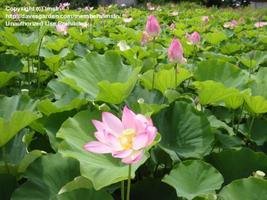
Because water lotus are viable for so long, they are also somewhat easy seeds to find. If you can find a dried seedpod from a florist, oftentimes the seeds within will sprout just as purchased seed stock. Fellow gardeners will frequently have extra lotus seeds on hand either because they've given up on successful germination or because many people don't have space for more than a couple lotus plants.
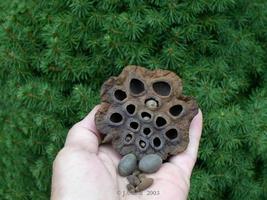
Basics of starting Nelumbo
On the other hand, due to the lotus seed's resistance to germination, it is more difficult to start than your average plant. You must break through the fused seed coats in order to spur germination. But it is not impossible! You just have to know a few tricks and make a few special accommodations and starting a lotus from seed will be easy.
Lotus seeds are about the size of a small olive and are very hard. On one end they have a sharp point and the other end, which will sprout once germinated, looks like a small dimple.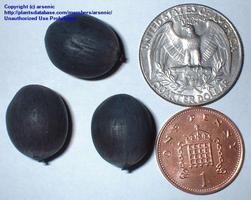
To start the germination of the Nelumbo seed, you must first nick or scarify the nearly impenetrable surface. This is trickier than it sounds; nicking a morning glory seed will seem like child's play in comparison. The easiest way to break through the seed coating of a Nelumbo seed is to grasp it tightly with needle nose pliers or the like, taking care not to crack the seed, and rub it over medium grit sand paper, pavement, or any other rough surface on the side of the seed. You only want to file through the first seed coat, which will be apparent when you see a thin white-lined oval in the surface. Filing off a spot through the outer coat will allow water to penetrate to the core of the seed and begin germination.
After you have scarified the seed, you will need to place it in water that will remain at or above 70 degrees F for several days, maybe weeks, straight. If there is a slight variation below 70 degrees F, it might take longer to sprout and the seedling could grow slower.
People have had luck keeping the water warm in different ways:
No matter how you keep the water warm, you'll need to replace the water frequently in order to keep bacteria away from the seed. Germinating lotus seeds are notorious for rotting right under your nose. Change the water daily to keep the environment clean for the seed.
You will begin to see the seed swelling within several hours. It can swell up to twice the size of an ungerminating seed. Sometimes the seed will take on a fuzzy or milky look to its surface. Increase the water changes; sometimes this spells the end, sometimes it does not.
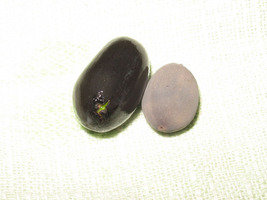
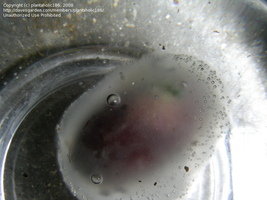
Within several days to several weeks, the seed will open like a clam and a seedling will begin to emerge. The original sprout is said to look like a fish hook because it is folded over and the first leave emulates a barb. Congratulations, you have successfully started a water lotus from seed. Now the difficult part begins.
Some pitfalls of starting lotus seeds:
Keep the seedling in warm and clean water that is well-lit once it sprouts. The seedling will begin to grow toward the light and will not unfurl its first leaf until it reaches the surface. The seedlings are not very tolerant of changes in water level so if you are going to move it, try to keep it in the same level of water.

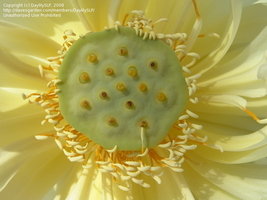

At this point you can put the seedling in a tub of water that has some kind of substrate such as clay or aquatic soil. Make sure the water stays warm and is well-lit by sunlight or fluorescent growing lights. Over the next several days or weeks, the seedling will send up three more small leaves at which point it will start to grow roots and the beginnings of a rhizome. It will nestle itself into the substrate and begin to establish itself by growing more roots and subsequent larger leaves.
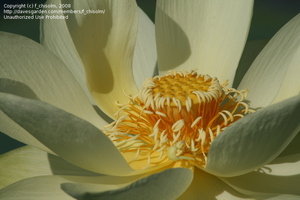
When your weather is past any danger of frost, set the tub out in a shaded spot while the seedling hardens off. You can then carefully transplant the seedling into whatever space you would like it to grow permanently. Many people grow lotus in a portable tub so that they can move them based on light and temperature changes or to enjoy the gorgeous flowers by a kitchen window. Others dig bogs specifically for lotus so there is plenty of room for them to grow. Remember that you'll want to keep the lotus at a similar depth to that in which it was sprouted and the plant will need ample room to grow. The more space the lotus has to grow, the bigger and healthier the leaves will grow and the more quickly it will bloom.
Revel in your seed starting success and enjoy your new lotus plant!
In memory of Trois, a warm gardening friend whom we will all miss.
Citation:
1. http://www.victoria-adventure.org/lotus/growing_from_seed.html
Thank you to the following DG members for their contributions to the Plant Files and forums for the use of their images:
DaylilySLP - forming seed podKorgBoy - soaked and dried seedsplantaholic186 - soaking seedf_chisolm - white lotus macro imagelmstn - field of lotusestrois- lotus budGinger749 - lotus flower, buds, and leavespalmbob - newly formed seedpodThumbnail - art_n_gardenJJsgarden - dried seed podarsenic - seeds with quarter
Copyright © www.100flowers.win Botanic Garden All Rights Reserved